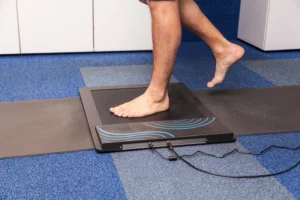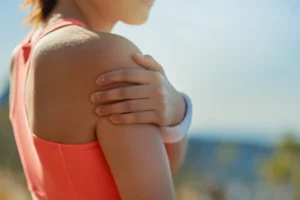Introduction: Delving into the Depths of Rotator Cuff Injuries
Rotator cuff injuries, a common yet often underestimated affliction, can cast a shadow over one’s ability to perform even the simplest of tasks. This comprehensive guide seeks to shine a spotlight on these intricate injuries, offering valuable insights into their causes, symptoms, diagnosis, treatment options, and preventative measures. Whether you’re an athlete, a fitness enthusiast, or simply curious about shoulder health in Paisley, this guide will equip you with the knowledge to understand and address rotator cuff injuries which are one of the pain causes of shoulder pain.
Section 1: The Marvels of the Rotator Cuff
Before we embark on the journey of understanding rotator cuff injuries, it’s crucial to appreciate the significance of the rotator cuff itself. Comprising a group of four muscles and their tendons, the rotator cuff encircles the shoulder joint, providing stability and enabling a wide range of motion. These muscles work in harmony to facilitate arm movements and shoulder rotation, making them essential for everyday activities and athletic pursuits.
The shoulder is a complex and highly mobile joint that allows for a wide range of motion in the upper extremity. It is made up of several bones, muscles, ligaments, and tendons. The primary bones and structures that make up the anatomy of the shoulder include:
- Humerus: The upper arm bone, which connects to the scapula and forms the ball-and-socket joint of the shoulder.
- Scapula (Shoulder Blade): A flat, triangular bone that forms the back part of the shoulder. It has several important features, including the acromion, coracoid process, and glenoid cavity.
- Clavicle (Collarbone): A long, slender bone that connects the sternum (breastbone) to the acromion of the scapula, helping to stabilize the shoulder joint.
- Glenoid Cavity: The shallow, socket-like portion of the scapula that forms the “socket” of the ball-and-socket shoulder joint. It articulates with the head of the humerus.
- Acromion: A bony projection of the scapula that forms the roof of the shoulder joint and articulates with the clavicle.
- Coracoid Process: A smaller bony projection of the scapula located in front of the acromion and provides attachment points for various muscles and ligaments.
The shoulder is surrounded by a network of muscles, tendons, and ligaments that help provide stability and enable its wide range of motion. Some of the key muscles of the shoulder include:
- Rotator Cuff Muscles: These four muscles (supraspinatus, infraspinatus, teres minor, and subscapularis) work together to stabilize the shoulder joint and facilitate various movements.
- Deltoid Muscle: The deltoid muscle covers the shoulder joint and is responsible for lifting and rotating the arm.
- Trapezius Muscle: This large muscle in the upper back and neck helps control the movement of the scapula and is involved in shoulder and neck movements.
- Pectoralis Major and Minor Muscles: These chest muscles are connected to the shoulder and play a role in movements like arm flexion and adduction.
The shoulder joint is further supported by several ligaments, including the coracoclavicular ligament, acromioclavicular ligament, and the glenohumeral ligaments.
In addition to these structures, there are bursae (small fluid-filled sacs) that help reduce friction between tendons, muscles, and bones in the shoulder, aiding in smooth movement.
Section 2: Unmasking the Culprits Behind Rotator Cuff Injuries
Rotator cuff injuries can arise from a myriad of causes, often involving a combination of factors. Overuse, repeated overhead movements, and abrupt trauma can strain or tear the tendons of the rotator cuff. Age also plays a role, as the tendons tend to weaken and become more susceptible to injury over time. Additionally, poor posture, inadequate warm-up routines, and improper lifting techniques can contribute to the development of these injuries.
Section 3: Diving into the Spectrum of Symptoms
Recognizing the tell tale signs of a rotator cuff injury is pivotal for prompt intervention. Individuals with such injuries often experience pain in the shoulder that radiates down the arm. This pain can intensify during movements that engage the rotator cuff muscles, such as lifting, reaching, or even sleeping on the affected side. Weakness and a noticeable reduction in range of motion are also common symptoms.
Section 4: Navigating the Diagnosis Maze
Diagnosing a rotator cuff injury involves a comprehensive evaluation by a medical professional. A physical examination that includes assessing range of motion and strength, along with a review of medical history, provides valuable initial insights. Imaging techniques like ultrasound, MRI, or X-rays may be employed to visualize the extent of the injury and guide treatment decisions.
Section 5: Forging a Path to Recovery
The treatment approach for rotator cuff injuries varies based on the severity of the injury and the individual’s goals. Conservative measures often include rest, ice, and anti-inflammatory medications to alleviate pain and reduce inflammation. Physiotherapy plays a pivotal role in rehabilitating the injured shoulder, focusing on strengthening the muscles around the rotator cuff and improving joint mobility.
Section 6: Exploring Surgical Solutions
In instances where conservative treatments fail to yield the desired results, surgical intervention may be considered. Arthroscopic procedures involve repairing or reattaching the torn tendons through small incisions. This minimally invasive approach aims to restore the shoulder’s function and alleviate pain, allowing individuals to regain their quality of life.
Section 7: Safeguarding Your Shoulders: Preventive Measures
Prevention is the cornerstone of shoulder health, and safeguarding against rotator cuff injuries requires proactive measures. Implementing proper posture, engaging in regular shoulder exercises to maintain strength and flexibility, and avoiding repetitive overhead motions can significantly reduce the risk of injury. Incorporating adequate warm-up routines and using proper lifting techniques further contribute to the preservation of the rotator cuff’s integrity.
Section 8: The Role of Patience in Rehabilitation
Recovery from a rotator cuff injury demands patience and dedication. Adhering to the prescribed rehabilitation program, including exercises and stretches, is essential for achieving optimal results. Gradually reintroducing activities that engage the shoulder and listening to the body’s cues are integral components of the rehabilitation journey.
Section 9: Rediscovering Shoulder Freedom
While rotator cuff injuries can present significant challenges, they need not define one’s journey. Armed with knowledge and a commitment to shoulder health, individuals can navigate the intricacies of these injuries, regain strength and mobility, and embark on a path to rediscover the freedom and joy of uninhibited shoulder movement.


